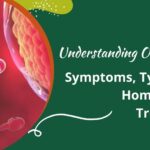Prevalence of Vitiligo
Approximately 1% of people worldwide suffer from vitiligo. Vitiligo can affect persons of any gender and skin tone. However, those with darker complexions tend to have more prominent lighter patches.
Know What Vitiligo Is!
A medical condition called vitiligo causes patches of lighter skin to develop when part of the skin loses its pigmentation. The destruction of melanocytes, which are cells that create pigment, results in the loss of pigmentation. Although vitiligo is primarily thought of as a skin condition, it can also affect the mucous membranes (inside the mouth and nose), hair, eyes, and inner ear. The face, dorsal hands, or feet are commonly affected.
When melanocytes, the cells that give your skin and hair their color, die, vitiligo symptoms develop. Generalized or nonsegmental vitiligo, the most prevalent kind, may be an autoimmune disease where the body’s immune system targets and destroys melanocytes. Segmental vitiligo, a form of the condition that is distinct from generalized vitiligo, may have a separate etiology and may be connected to the nervous system, according to research.
To what extent can vitiligo affect the body?
It can happen on any part of the body. Vitiligo typically affects the skin around the mouth, eyes, hands, ankles, elbows, and wrists. Although the disorder seldom causes complete skin pigment loss, it can occasionally affect substantial sections of skin. Alopecia areata, thyroid disease, and psoriasis are among the immunological conditions that people with vitiligo may also have. Some report that vitiligo develops as a result of psychological anxiety or physical trauma. Although it can affect anyone, darker-skinned persons are more likely to develop vitiligo. About 50% of vitiligo sufferers get it before the age of 20.
The following are the four skin conditions commonly misunderstood as vitiligo.
1. Leucoderma vs Vitiligo
Although the terms “vitiligo” and “leucoderma” are often used interchangeably, vitiligo is an autoimmune disease that causes leucoderma. In contrast, leucoderma is a more general skin condition that refers to any loss of skin color that results in white patches. Leucoderma is most commonly caused by vitiligo; however, it may also develop through trauma, burns, or chemical exposure.
Differences between leucoderma and vitiligo
Clinically, Vitiligo and Leucoderma both appear as white spot on skin that are only distinguishable from their underlying causes.
- Causes
Acute emotional trauma or stress, autoimmune diseases, hormonal changes, constant episodes of jaundice or typhoid, extended antibiotic treatment, or corticosteroid medication are the main causes of vitiligo. Leucoderma usually develops after physical trauma, such as an ulcer, burn, or cut. The resulting scar will eventually become a white spot that occasionally gets bigger with time.
- Diagnosis and management
Since these are two clinical diagnoses, choosing a course of treatment requires a comprehensive physical and medical history, paying particular attention to any changes in the skin. Most patients have benefited from homeopathic treatment using the vitiligo treatment cream and have experienced quick and long-lasting relief.
2. Tinea Versicolor vs Vitiligo
When too much yeast develops on your skin, it can cause tinea versicolor (TV), also known as pityriasis versicolor. A rash that appears to be circular, with flat areas that may be lighter or darker than the surrounding skin, is caused by too much yeast. It usually affects the back and chest and requires treatment by tinea versicolor specialists. On the other hand, an autoimmune condition, called vitiligo, causes the skin cells to become less pigmented. Melanocytes, which synthesize color, are usually found in your skin. The melanin that gives skin its color is synthesized by them. These cells that are responsible for developing the pigment are not present in vitiligo patches, according to Dr. Kanchan, Bharat Homeopathy.
3. Pityriasis Alba vs Vitiligo
Commonly affecting children and teenagers, pityriasis alba is a common, mild skin disorder. It usually affects the face, neck, and upper arms and develops as light, round, or oval patches on the skin. The patches typically have blurred edges and are lighter than the surrounding skin, but they are typically not distinctly white as those in vitiligo. Pityriasis alba is distinguished by modest hypopigmentation, which means the skin simply becomes lighter rather than completely colorless, in contrast to vitiligo, which is characterized by a complete loss of pigment.
In addition to dry skin issues, which are sometimes made worse by frequent bathing or the use of harsh soaps, environmental factors such as exposure to the sun and wind can also make it worse. Susceptibility may also be influenced by genetic factors, particularly in families where skin sensitivity runs in the family. Thankfully, pityriasis alba is thought to be harmless but requires a proper pityriasis alba treatment.
4. Albinism vs Vitiligo
Since both albinism and vitiligo cause the skin to appear light or white, they may look the same. Albinism is a genetic trait that causes the skin to turn very light throughout the body, with the exception of partial albinism. Vitiligo is an autoimmune disease that causes white spot on skin. This is the main distinction between the two conditions.
Homeopathic Vitiligo Treatment
In order to provide tailored patient care, homeopathic medicine employs a holistic approach to patient care. Homeopathy acknowledges that stress and genetic predisposition may work together to cause some diseases. Homeopathy can be more effective in the early stages of a disease, even before conventional therapy usually starts, because it takes into account the patient’s vulnerability to specific types of stress. The fundamental concept behind homeopathy’s holistic treatment for vitiligo is that symptoms are the immune system’s attempt to find equilibrium. This helps to increase the immune system’s function. The foundation of homeopathic medicine for white patches on skin is based on the principle of “like cures like”, which states that if a substance can produce a similar symptom profile in a healthy living thing, then there is a high chance that it will strengthen the body’s defense mechanisms in a diseased body with similar symptoms.
Bharat Homeopathy: Best Vitiligo Treatment in Gurgaon
Vitiligo can be quite challenging for some, but given the right treatment approach with vitiligo treatment cream, its effects can be managed or even reversed. Homeopathy is holistic, safe, and individualized for addressing the basic cause of vitiligo. Bharat Homeopathy and its unique approach offer patient-centered care at the physical and emotional plane of the suffering, giving hope and healing for people afflicted with white spots on their skin while providing vitiligo natural treatment.


